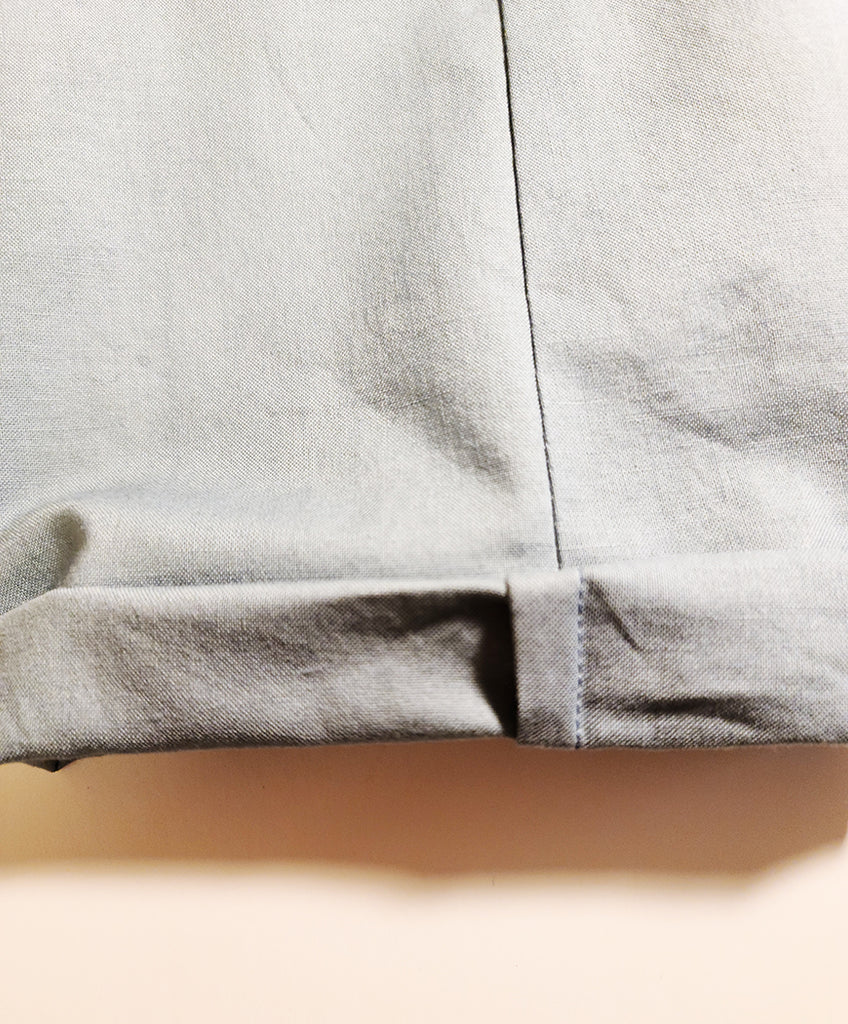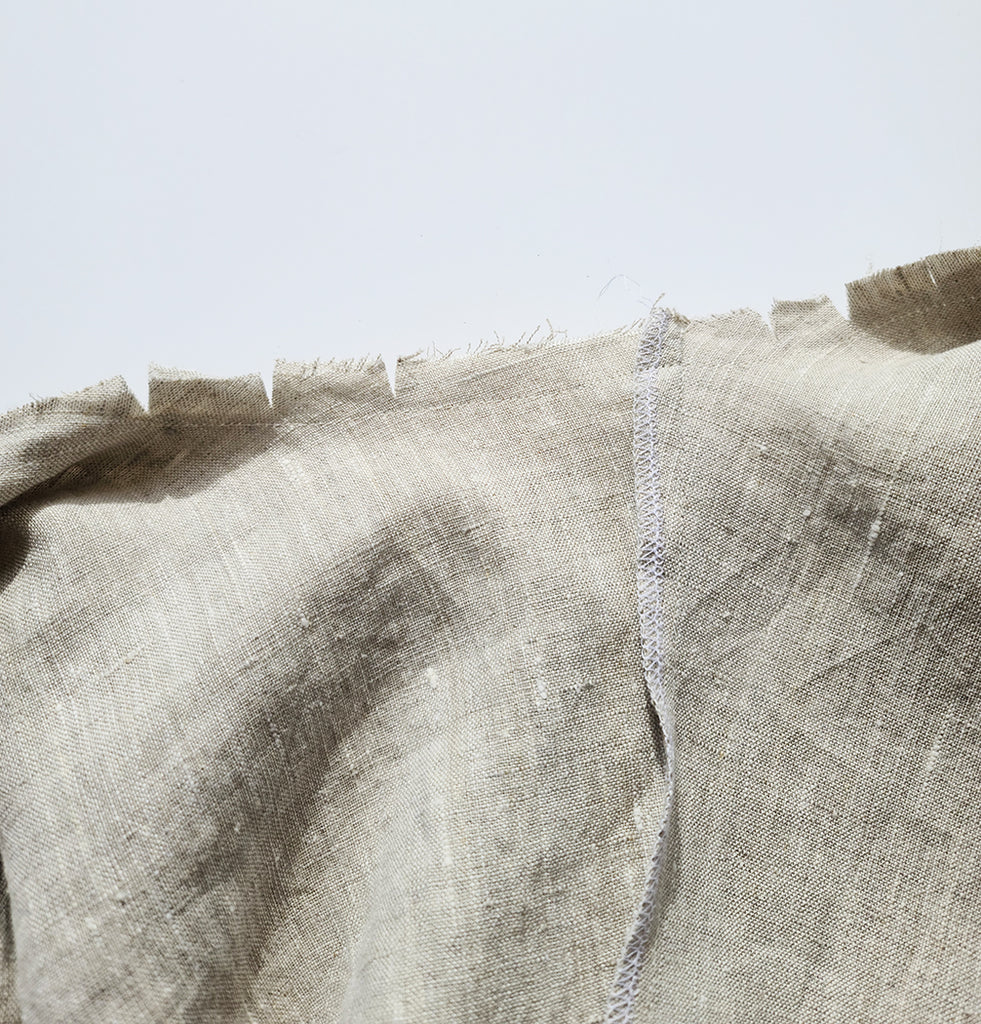






























2 g. Edgestitch/topstitch the BACK POCKET in place starting from the top side seam down, pivot at the bottom corners and up the inner side. It is optional to make another row of topstitching (double or single stitching is your choice). Repeat with second BACK POCKET (optional).
2 h. Reinforce the top inner side with a small and tight zig-zag stitch/bar tack back and forth a few times to secure the BACK POCKET. Repeat with second
BACK POCKET (optional). I opted instead to stitch a triangle in the pocket corner to give extra support but a bar tack is best if the pocket is going to get a lot of wear and tear.

SIDE SEAMS (VERSIONS #1 & #2)
If you are making the tapered leg version #1 and plan to roll up the bottom hem, I will be showing you the option to flat-fell the side seams so that they look more polished when rolled up. You don't have to do a flat felled side seam, however, if you'd like to, just skip ahead a bit to that part.
First I am going to show you the basic side seam method because I am making version #2 and won't be rolling up the pant legs on this pair.
This part isn't in the instructions however, I would mark the top of your SIDE PANT (5) because it is very easy to get this piece turned around.

3 a. With right sides together, pin the SIDE PANT (5) to the BACK PANT (2 or 4) at the side seam, aligning notches.


3 a. Then stitch the pieces together with a 5/8”/ 16mm seam allowance.
3 b. Now attach the FRONT PANT (1 OR 3) to the other side seam of the SIDE PANT (5).

Then finish both of the seam edges and press each seam so it is facing toward the side panel. Repeat for the other set.

Press on the wrong side as well as the right side to be sure the seams are well pressed. 
3 c. Press the seams toward the SIDE PANT. Edgestitch/topstitch along the side seams on the SIDE PANT. Press. Repeat for the other set.
I did not actually topstitch this pair so below is an illustration of the step.

4 a. With right sides together, fold the pant length wise and align the inseams together, matching notches. Pin in place and then stitch together with a 5/8”/16mm seam allowance. Finish the seam edges together and press toward the back. Repeat with the other set.


OPTIONAL FLAT FELLED SEAMS FOR VERSION #1
I apologize for the poor photos. I didn't actually make the complete pants for version #1, but rather, this is a mock up of how to do the flat felled seams and the lighting was poor when I took these photos.
3 a. With wrong sides together, pin the SIDE PANT (5) to the BACK PANT (2) at the side seam, aligning notches and stitch together with a 5/8"/ 16mm seam allowance. 3 b. Do the same for the SIDE PANT (5) to the FRONT PANT (1).
Repeat for the other set.

Remove the basting stitch that holds the front pocket down on the Front side seam otherwise it will show up on your finished side seam.

3 c. Finger press the seams open and then trim the inner seam allowance edge (the seam closer to the SIDE PANT) down to 1/4”/6mm.

The illustration below may be more clear as to which seams to trim.

3 d. Now lay the BACK PANT to SIDE PANT seam together and fold the BACK PANT seam (the longer side seam) over the trimmed seam of the SIDE PANT so that the edge meets the stitch line. The angle in the photo below doesn't look like the edge of the seam is touching the stitching but it is. Press. Repeat with the FRONT PANT to SIDE PANT seam allowance and then with the other set. Be sure the seams are even in width because this is what will be showing on the outside of your garment.

3 e. Lay the pant right side up and press the folded seam allowances toward the SIDE PANT. Press and pin in place. Repeat with the FRONT PANT to SIDE PANT seam allowance and then with the other set.

3 f. Stitch the seams down through all thicknesses. Press. Repeat with second set.

This is what the inside of your finished, flat felled seam will look like when the hem is rolled up.

OPTIONAL PARTIAL FRENCH SEAM FOR VERSION #1
Again - my photos aren't great and this is a mock up rather than real pants.
The reason for the partial French seam and not a complete French seam all the way through the inseam is that I thought it would create bulk as it would be difficult to stitch it down to keep but that is an option for those willing to try.
4 a. Mark the front and back inseam 6”/15cm up from the bottom hem. Mark with a pin or tailor’s chalk.

4 b. With wrong sides together, and using a scant 1/4”/6mm seam allowance, start stitching the inseam together from the mark down to the hem. Trim any fraying threads and press the seam to one side. Repeat with second leg.

4 c. Now turn the pant leg inside out so the right sides are together.
Clip just above the French seam so that the rest of the seam can lay flat.

Using a 3/8”/10mm seam allowance, enclose the raw edges of the first seam by stitching from the hem up through the entire inseam. Only the 6”/15cm area will be French seamed while the upper section will have a raw edge.
Finish the rest of the seam edges together and press toward the back.Repeat with the second leg.

This is how the French seam will look when the finished pant hem is rolled up.

THE RISE
5 a. Now turn one pant set right side out and slip the leg down into the leg of the inside out pant half so that right sides are together. Align crotch seam of the rise and pin in place.



5 b. Stitch the front through the back rise with a 5/8”/16mm seam allowance. Stitch again over the first row of stitching to reinforce the seam.
Clip the curves without clipping at the bottom crotch. Finish the edges together.


5 c. Press the seams toward the wearer’s right side. Edgestitch/ topstitch on the the right side of the seam all along the rise seam. The topstitching is optional and I am omitting it on this pair of pants but below is an illustration of the step.

ATTACHING THE WAISTBAND FACING
Before I start sewing my WAISTBAND FACINGS, I like to mark the top backs of them so I know what end is what. You can see below that I have marked them with pins.

6 a. With right sides together, sew the WAISTBAND FACINGS (8) together at the center front and center back short ends. Press the seams open.
6 b. Then turn up the bottom, unnotched edge of the WAISTBAND FACING 3/8”/10mm toward the inside and press.

Going back a step to 6 a. -
If you've taken just slightly smaller or larger seam allowances in the pant side seams, that can cause the WAISTBAND FACING too large or small for the pant waist so I like to check before sewing one of the facing seams. I actually prefer to just sew one seam (say the center back seam) of the WAISTBAND FACING and then hold up the facing to the pant waist to see how much of a seam allowance I should use for the Front WAISTBAND FACING seam. 
6 c. With right sides together, pin the WAISTBAND FACING to the top of the pants, aligning notches and center front and center back seams.

Then stitch the facing to the pant waist with a 5/8”/16mm seam allowance.

Grade the seam allowance by trimming one layer of the seam allowance shorter than the other so there isn't such a thick, lumpy seam of fabric when the facing is turned right side out but rather, the thickness graduates. Press the seam toward the facing.

6 d. Understitch the WAISTBAND FACING by stitching close to the seam on the WAISTBAND FACING side and catching the seam allowance on the backside.

This is also a good time to stitch a label in the back of the WAISTBAND FACING.

Turn the WAISTBAND FACING toward the inside. Press and pin in place.

6 e. Starting near the center back, create the elastic tunnel by stitching the WAISTBAND FACING down 1 7/8”/4.75cm away from the folded edge. Stop stitching before you complete the tunnel - leaving an opening approximately 2”/ 5cm wide to insert the elastic.


6 f. Cut a piece of 1 1/2”/ 40 mm wide elastic so that the length fits perfectly around your waist without stretching plus an additional 1/2”/ 13mm.
6 g. Attach a sturdy safety pin to one end of the elastic and insert it through the waistband tunnel opening. Push the safety pin through the tunnel until the elastic is all the way through.

6 h. When the elastic is completely through the tunnel, make certain that it hasn’t twisted on its journey. Pin the elastic together and try the pants on to be sure the elastic length is comfortable and adjust if needed.

Now overlap the elastic 1”/2.5cm and stitch back and forth across the overlapped area several times to ensure the elastic stays tacked together.
I sometimes stitch the elastic together and then fold the seam to one side and reinforce it together as I have done here.


6 i. Complete the stitching to enclose the waistband elastic.

6 j. Distribute the waist gathers evenly. Now stitch over the top of the existing topstitching, if you did topstitch, or stitch in the ditch as I did here for the distance of the waistband height at the center front and center back seams to secure the elastic and keep it from rolling once it is on.

There stitching in the ditch is pretty much hidden but secure's the elastic. Repeat this in the center back. If you added a label, you can just stitch above and below the label. 
HEMMING THE PANTS (VERSION #2)
7 a. Turn the bottom leg up 3/8”/10mm and press.

Then turn up the bottom another 1 1/8”/2.85cm for a deep hem and press and pin in place. Repeat with the second leg.
7 b. Stitch the hem in place 1”/2.5cm away from the bottom edge. Press. Repeat with the second leg.

HEMMING THE PANTS (VERSION #1)
7 a. Turn the bottom leg up 3/8”/10mm and press. Then turn up the bottom another 1/2”/13mm and press. Repeat with the second leg.
7 b. Stitch the hem in place 3/8”/10mm away from the bottom edge. Press. Repeat with the second leg.
7 c. Roll the bottom hem of the legs up two or three times.
YOU ARE FINISHED YAY!
Thank you for joining in!
Peggy



